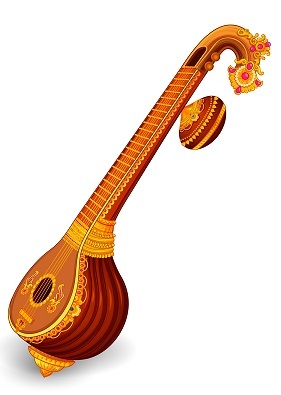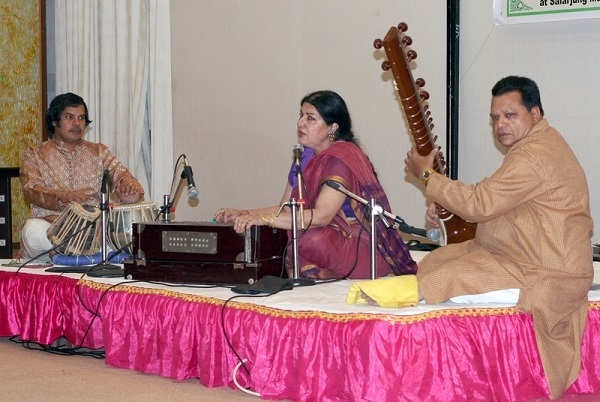


Hindustani classical music is an ancient and complex musical art form that has been handed down from generation to generation. This style of music allows for freedom and self-expression while still following the fundamental rules and motifs of the genre. It revolves around two primary components: ragas, which are melodic modes, and talas, which are rhythmic cycles. A variety of instruments are used in this form of music, such as plucked stringed instruments like sitar, sarod, santoor, tambura, and tanpura, and wind instruments like shehnai and flute. Hindustani music is still popular today and continues to be an important part of Indian culture.
Hindustani classical music is an ancient genre of North Indian music that has been passed down through generations of musicians. It is a sophisticated style characterized by intricate melodies, complex rhythms, and impressive vocal abilities. Its two-part raga system combines tonal structure with rhythmic diversity, creating a unique and captivating sound. This timeless art form is typically accompanied by instruments like the sitar or tabla and is popular in India, Pakistan, and Bangladesh. Historically performed to honour gods or express emotion through song, Hindustani classical music remains a powerful medium for conveying meaningful stories and messages even today.
Ustad Amir Khan is widely regarded as the father of Hindustani music, having revolutionized the genre in the early-mid 1900s. His innovative approach to sarod playing and vocal performance, known as khayal singing, elevated Indian classical music to a new level and earned him recognition on the international stage. His creative use of ragas and improvisation techniques pushed the boundaries of tonality, creating a style that continues to inspire contemporary Hindustani musicians and stir the souls of music lovers around the world.
Khayal is the most popular form of Hindustani classical music. It is based on the improvisational and melodic style of singing. Khayal usually follows a particular traditional structure, beginning with the alaap, followed by the composition of the song.
Thumri is a light and romantic form of Hindustani classical music. It is often based on a semi-classical rag and includes elements of light and poetic lyrics. The style of singing is typically very expressive and incorporates a lot of improvisation.
Dhrupad is the oldest and most complex form of Hindustani classical music. It follows a rigorous structure and is based on precise and precise melodic patterns. Dhrupad is typically performed with accompaniment from a tanpura, and is known for its deep and spiritual sound.
Tappa is a fast-paced and energetic form of Hindustani classical music. It is based on a cyclic structure and is typically performed with accompaniment from a tanpura. Tappa is known for its intricate melodic patterns and its use of complex rhythms.
Ghazal is a form of Hindustani classical music that is based on a poetic structure. It is usually composed of short couplets and is known for its romantic and lyrical style of singing. Ghazal is also known for its use of improvisation and its expressive melodies.
The 12 notes in Hindustani music are
Sa: The tonic or basic note, also known as "Shadja"
Re: The second note of the scale, also known as "Rishabh"
Ga: The third note, also known as "Gandhar"
Ma: The fourth note, also known as "Madhyam"
Pa: The fifth note, also known as "Pancham"
Dha: The sixth note, also known as "Dhaivat"
Ni: The seventh note, also known as "Nishad"
Sa': The octave of the tonic, also known as "Komal Shadja"
Re': The ninth note, also known as "Komal Rikshav"
Ga': The tenth note, also known as "Tivra Gandhar"
Ma': The eleventh note, also known as "Tivra Madhyam"
Pa': The twelfth note, also known as "Komal Pancham"
The seven ragas of Indian classical music are Bhairav, Malkauns, Yaman, Bhupali, Marwa, Puriya, and Todi. These ragas are the foundation of North Indian classical music and are used for improvisation. Bhairav is a very ancient raga, typically associated with mornings and good luck. Malkauns is a mysterious raga, often played during the night. Yaman is the most popular morning raga, known for its calming and spiritual qualities. Bhupali is a raga of love and devotion. Marwa is a joyful raga, typically played in celebrations. Puriya is a raga of strong emotions and longing. Todi is a raga of relaxation and contemplation, ideal for introspection and meditation. Altogether, these seven ragas create a vibrant and diverse range of sounds and emotions that make Indian classical music unique.

Hindustani classical music
Description-Hindustani classical music is the classical music of northern regions of the Indian subcontinent.
Hindustani classical music has been a source of solace and delight for centuries. Its tranquillizing ragas and soothing melodies offer a respite from the bustle of modern life. Although its structure has changed over time, Hindustani classical music has endured and remains one of India's oldest forms of storytelling. Thanks to contemporary musicians dedicated to bringing it to the masses, this captivating style of music will be enjoyed for many years to come.
Q1. How is Hindustani Classical Music used in religious ceremonies?
Ans. Hindustani Classical Music is used to create a spiritual atmosphere during religious ceremonies, and to add an emotional component to devotional songs.
Q2. How do you infuse Indian Classical Music into your everyday life?
Ans. By incorporating Indian Classical Music into my daily practice, such as singing, listening, or playing an instrument, I can experience the joy and beauty of this ancient art form.
Q3. Are there any international virtuosos of Hindustani Classical Music?
Ans. Yes, some internationally renowned virtuosos of Hindustani classical music include Ustad Bismillah Khan, Ustad Ali Akbar Khan, Ustad Zia Fariddudin Dagar and Pandit Ravi Shankar.